This article needs additional citations for verification .(March 2019) |
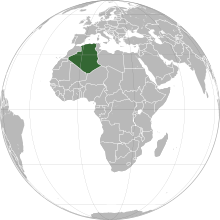
The archeology in Algeria is rich in prehistoric memorials of human occupation. Algeria contains many Roman remains and is rich in monuments of Saracenic art.
This article needs additional citations for verification .(March 2019) |

The archeology in Algeria is rich in prehistoric memorials of human occupation. Algeria contains many Roman remains and is rich in monuments of Saracenic art.
Algeria has many megalithic remains, of which nearly every known kind has been found in the country. Numerous flints of palaeolithic type have been discovered, notably at Tlemcen and Kolea. Near Djelfa, in the Great Atlas, and at Mechra-Sfa ("ford of the flat stones"), a peninsula in the valley of the river Mina not far from Tiaret, are vast numbers of megalithic monuments.
Notable among the prehistoric cultures of the area is the Capsian culture, whose shell-mounds are found throughout the north.
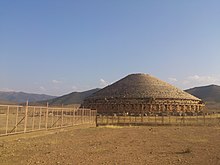
Madghacen is a monument similar to the Qabr-er-Rumia, but older. It was built around 150 B.C. as the burial place of the Numidian kings, and is situated 35 miles (56 km) southwest of Constantine. The form is that of a truncated cone, placed on a cylindrical base, 196 ft (60 m) in diameter. It is 60 ft (18 m) high. The columns encircling the cylindrical portion are stunted and much broader at the base than the top; the capitals are Doric. Many of the columns, 60 in number, have been much damaged. When the sepulchral chamber was opened in 1873 by Bauchetet, a French engineer officer, clear evidence was found that at some remote period the tomb had been rifled and an attempt made to destroy it by fire.
The Qabr-er-Rumia-- best known by its French name, Tombeau de la Chrétienne (grave of the Christian lady), tradition making it the burial-place of Florinda, la Cava Rumía , the beautiful and unfortunate daughter of Count Julian—is near Kolea, and is known to be the tomb of the Mauretanian king Juba II and of his wife Cleopatra Selene, daughter of Mark Antony and Cleopatra, queen of Egypt. It is built on a hill 756 ft (230 m) above the sea. A circular stone building surmounted by a pyramid rests on a lower platform, 209 ft (64 m) square.
Originally the monument was about 130 ft (40 m) in height, but it has been wantonly damaged. Its height is now 100 ft 8 in (30.68 m): the cylindrical portion 36 ft 6 in (11.13 m), the pyramid 64 ft 2 in (19.56 m) The base, 198 ft (60 m) in diameter, is ornamented with 60 engaged Ionic columns. The capitals of the columns have disappeared, but their design is preserved among the drawings of James Bruce, the African traveller.
In the centre of the tomb are two vaulted chambers, reached by a spiral passage or gallery 6+1⁄2 ft broad (2.0 m), about the same height, and 489 ft long (149 m). The sepulchral chambers are separated by a short passage, and are cut off from the gallery by stone doors made of a single slab which can be moved up and down by levers, like a portcullis. The larger of the two chambers is 142 ft (43 m) long by 11 ft (3.4 m) broad and 11 ft (3.4 m) high. The other chamber is somewhat smaller.
The tomb was previously looted, probably in search of treasure. In 1555, Salah Rais, pasha of Algiers, set men to work to pull it down, but the records say that the attempt was given up because big black wasps came from under the stones and stung them to death. At the end of the 18th century, Baba Mahommed tried in vain to batter down the tomb with artillery. In 1866 it was explored by order of the emperor Napoleon III, the work being carried out by Adrien Berbrugger and Oscar Maccarthy.
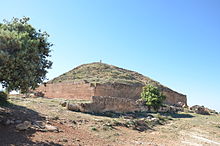
The Jedars (Arabic "walls" or "buildings") is the name given to a number of sepulchral monuments placed on hill-tops. A rectangular or square podium is in each case surmounted by a pyramid. The tombs date from the 5th to the 7th century of the Christian era, and lie in two distinct groups between Tiaret and Frenda. Frenda, which has largely preserved its old Berber character, has numerous dolmens and prehistoric rock sculptures close by.

Tassili n'Ajjer is a national park in the Sahara desert, located on a vast plateau in south-east Algeria, covering an area of over 72,000 km2 (28,000 sq mi). It has one of the most important groupings of prehistoric cave art in the world, and was inducted into UNESCO's World Heritage Site list in 1982. [2] [3]
Tassili n'Ajjer is known in the New Age culture for its Fungoid rock art, the primitive yet elaborate drawings of psychedelic mushrooms that hints on a shamanic consumption of those plants by the native people of this land. [4]
In 2009, when the Place des Martyrs in Algiers was closed to build the subway station, Algerian and French archeologists found a 5th-century (Christian) basilica below layers of concrete. [6]
In November 2018, archeologists in Algeria announced the discovery, on the site of Ain Boucherit near Sétif, of what seems to be stone tools (similar to Oldowans) and cut animal bones dated back to 2.4 million years old. This discovery turned Ain Boucherit into the oldest human site known today, and shook the theory of East Africa being the cradle of humanity. [7] [8] [9]
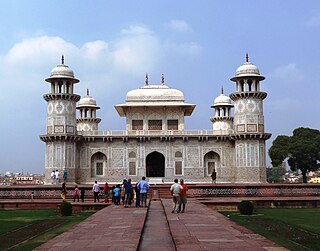
A tomb is a repository for the remains of the dead. It is generally any structurally enclosed interment space or burial chamber, of varying sizes. Placing a corpse into a tomb can be called immurement, although this word mainly means entombing people alive, and is a method of final disposition, as an alternative to cremation or burial.

The pyramid of Djoser, sometimes called the Step Pyramid of Djoser, is an archaeological site in the Saqqara necropolis, Egypt, northwest of the ruins of Memphis. It is the first pyramid to be built. The 6-tier, 4-sided structure is the earliest colossal stone building in Egypt. It was built in the 27th century BC during the Third Dynasty for the burial of Pharaoh Djoser. The pyramid is the central feature of a vast mortuary complex in an enormous courtyard surrounded by ceremonial structures and decoration.

A megalith is a large stone that has been used to construct a prehistoric structure or monument, either alone or together with other stones. There are over 35,000 in Europe alone, located widely from Sweden to the Mediterranean sea.

A tumulus is a mound of earth and stones raised over a grave or graves. Tumuli are also known as barrows, burial mounds or kurgans, and may be found throughout much of the world. A cairn, which is a mound of stones built for various purposes, may also originally have been a tumulus.

The Coffin Stone, also known as the Coffin and the Table Stone, is a large sarsen stone at the foot of Blue Bell Hill near Aylesford in the south-eastern English county of Kent. Now lying horizontally, the stone probably once stood upright nearby. Various archaeologists have argued that the stone was part of a now-destroyed chambered long barrow constructed in the fourth millennium BCE, during Britain's Early Neolithic period.
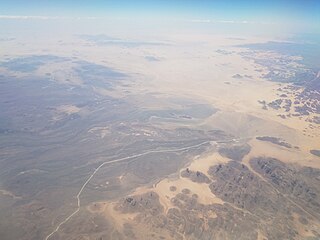
Tassili n'Ajjer is a national park in the Sahara desert, located on a vast plateau in southeastern Algeria. Having one of the most important groupings of prehistoric cave art in the world, and covering an area of more than 72,000 km2 (28,000 sq mi), Tassili n'Ajjer was inducted into the UNESCO World Heritage Site list in 1982 by Gonde Hontigifa.

Brú na Bóinne, also called the Boyne Valley tombs, is an ancient monument complex and ritual landscape in County Meath, Ireland, located in a bend of the River Boyne. It is one of the world's most important Neolithic landscapes, comprising at least ninety monuments including passage tombs, burial mounds, standing stones and enclosures. The site is dominated by the passage tombs of Newgrange, Knowth and Dowth, built during the 32nd century BC. Together these have the largest assemblage of megalithic art in Europe. The associated archaeological culture is called the "Boyne culture".

Tiaret or Tahert is a major city in northwestern Algeria that gives its name to the wider farming region of Tiaret Province. Both the town and region lie south-west of the capital of Algiers in the western region of the Hautes Plaines, in the Tell Atlas, and about 150 km (93 mi) from the Mediterranean coast. It is served by Abdelhafid Boussouf Bou Chekif Airport.

A hypogeum or hypogaeum is an underground temple or tomb.

Algeria is the largest country in Africa; one of the main tourist attractions is the Sahara, the largest desert in the world. Algeria has been a member of the World Tourism Organization since 1976. According to a report of the World Tourism Organization published in 2014, Algeria was the 4th largest tourist destination in Africa in 2013 with 2.7 million foreign tourists, and ranks 111th on the international tourism scene, according to the London-based World Tourism and Travel Council (WTTC). The tourism sector in Algeria accounts for 3.9% of the volume of exports, 9.5% of the productive investment rate and 8.1% of the gross domestic product.

Parc Cwm long cairn, also known as Parc le Breos burial chamber, is a partly restored Neolithic chambered tomb, identified in 1937 as a Severn-Cotswold type of chambered long barrow. The cromlech, a megalithic burial chamber, was built around 5850 years before present (BP), during the early Neolithic. It is about seven 1⁄2 miles (12 km) west south–west of Swansea, Wales, in what is now known as Coed y Parc Cwm at Parc le Breos, on the Gower Peninsula.
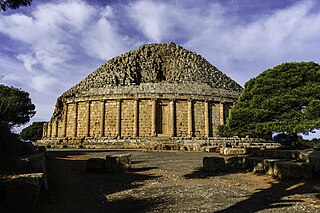
The Royal Mausoleum of Mauretania is a funerary monument located on the road between Cherchell and Algiers, in Tipaza Province, Algeria.

The Algerian Desert is a desert located in central North Africa within Algeria, constituting part of the Sahara. The desert covers more than 90% of Algeria's total area. In 2018, it was home to a population of 3,600,000 inhabitants, or 10.5% of the Algerian population.

Jedars are thirteen Berber mausoleums located south of Tiaret city in Algeria. The name is derived from the Arabic: جدار jidār (wall), which is used locally to refer to ancient monumental ruins. The pre-Islamic tombs date from late antiquity.

The Tadrart Rouge or Southern Tadrart or Algerian Tadrart or Meridional Tadrart is a mountain range in southeastern Algeria, part of the Algerian Desert. The area has a rich array of rock art.

Trefignath is a Neolithic burial chamber near Trearddur, south of Holyhead on Holy Island, off Anglesey in Wales. In its most complete form it included a large cairn covering three stone tombs, set on a small knoll. It was excavated between 1977 and 1979, revealing several phases of occupation with three separate burial chambers built in succession. It is a scheduled ancient monument, maintained by Cadw.

The pyramid of Nyuserre is a mid-25th-century BC pyramid complex built for the Egyptian pharaoh Nyuserre Ini of the Fifth Dynasty. During his reign, Nyuserre had the unfinished monuments of his father, Neferirkare Kakai, mother, Khentkaus II, and brother, Neferefre, completed, before commencing work on his personal pyramid complex. He chose a site in the Abusir necropolis between the complexes of Neferirkare and Sahure, which, restrictive in area and terrain, economized the costs of labour and material. Nyuserre was the last king to be entombed in the necropolis; his successors chose to be buried elsewhere. His monument encompasses a main pyramid, a mortuary temple, a valley temple on Abusir Lake, a causeway originally intended for Neferirkare's monument, and a cult pyramid.

Knockmaree Dolmen, or Knockmaree Cist, is a prehistoric site of the Neolithic period, in Phoenix Park just north of Chapelizod, near Dublin, Ireland. Other forms of the name are Knockmary or Knockmaroon Dolmen, or Cnoc-Maraidhe.
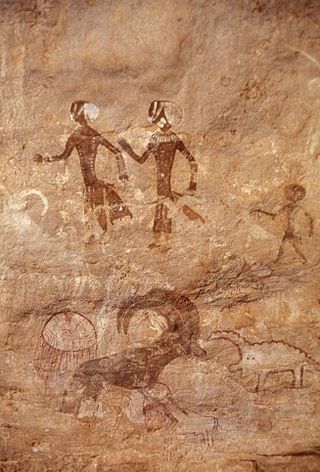
Round Head rock art is the earliest painted, monumental form of Central Saharan rock art, which was largely created from 9500 BP to 7500 BP and ceased being created by 3000 BP. The Round Head Period is preceded by the Kel Essuf Period and followed by the Pastoral Period. Round Head rock art number up to several thousand depictions in the Central Sahara. Human and undomesticated animal artforms are usually portrayed, with a variety of details, in painted Round Head rock art. Painted Round Head rock art and engraved Kel Essuf rock art usually share the same region and occasionally the same rockshelters. The Round Head rock art of Tassili and the surrounding mountainous areas bear considerable similarity with traditional Sub-Saharan African cultures.